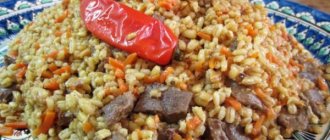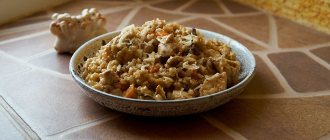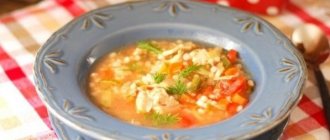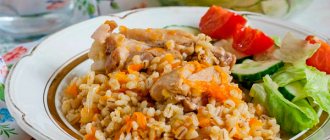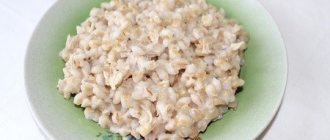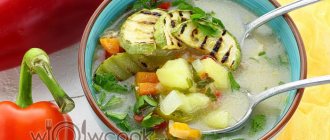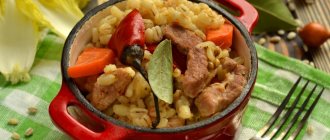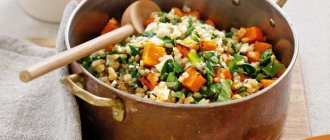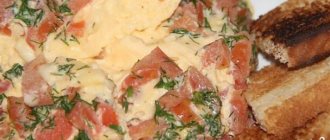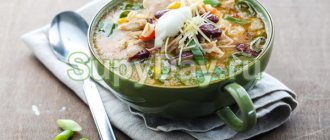Composition and benefits
Menu options for nursing mothers often recommend buckwheat or oatmeal, but rice porridge cannot be discounted. Cereals are a source of vegetable protein, which the body cannot do without. The concentration of minerals, vitamins and amino acids in 100 grams covers a third of the daily requirement of an adult.
The advantage of rice during breastfeeding is the absence of gluten: an allergenic sticky protein that is difficult to digest by the body.
Due to the starch content, cereals are digested without irritating the gastrointestinal tract, therefore it is recommended for patients with ulcers and gastritis.
Table 1 – List of nutrients in rice
| Element: | , mg: | % of normal: | Action: |
| B5 (Pantothenic acid) | 1.45 | 30 | Participates in the synthesis of neurotransmitters and the production of hormones. Treats arthritis, allergies and heart disease. |
| B6 (pyridoxine) | 0.51 | 26 | Improves digestion, in combination with Ca, strengthens the heart muscle and nervous system. |
| Iron | 1.8 | 10 | Participates in hematopoiesis, treats anemia, strengthens the immune system. |
| Potassium | 268 | 11 | In combination with Mg, they regulate water balance, the stability of the heart, and the conductivity of nerve impulses. |
| Magnesium | 143 | 36 | |
| Manganese | 3.75 | 173 | Antioxidant, renews cells, stimulates brain function, regulates nervous reactions. |
| Copper | 277 | 28 | Participates in hematopoiesis and synthesis of nerve mediators. Increases blood clotting. |
| PP (niacin) | 4.31 | 22 | Regulates cholesterol levels, strengthens blood vessels, stimulates blood flow. Regenerates skin cells. Stabilizes the nervous system. |
| Phosphorus | 264 | 33 | Prevents kidney failure, strengthens the skeletal system and tooth enamel. |
| Zinc | 2 | 17 | Anti-inflammatory, antibacterial effect, improves attention and memory, stimulates the growth and strengthening of hair and nails. |
Among the 11 reasons why the Japanese live long is eating rice as a side dish. Properly boiled cereal in combination with seafood and vegetables is rightfully recognized as an integral part of a healthy diet.
Is it possible to have rice while breastfeeding?
Rice during breastfeeding is allowed to be included in the menu from the first days of a baby’s life. An allergy to a product can only be caused by the individual characteristics of the child’s body.
An important component is starch, a provocateur of constipation, so the reaction that the mother should monitor after trying rice is the baby’s stool and behavior in the evening hours. Moodiness, decreased frequency of bowel movements, and a bloated stomach are reasons to give up cereals for 2-3 weeks.
At 3-4 months, the baby’s gastrointestinal tract is still improving, learning to process increasingly complex components from mother’s milk. In 85% of cases, by this age, rice dishes are already included in the woman’s menu after childbirth.
What kind of rice is best for a nursing mother to eat?
When choosing a product, it is better to choose unpolished grains: the grain shells retain the original composition of vitamins and minerals. Brown (unpolished) rice is considered the healthiest: when cooked, the grains remain dense and the dish does not become soggy.
When choosing a color, preference is given to brown and red varieties. The maximum concentration of minerals is in wild black rice, which is also beneficial for nursing mothers. Common white rice undergoes deep heat treatment, so it retains less than a third of its original composition.
Yellow rice is also used for breastfeeding. Steamed varieties are thermally processed, but retain 80% of the beneficial elements. The structure is crumbly, cooks for 20-25 minutes.
To reduce the risk of colic and bloating of the baby, it is recommended to freeze rice: after thawing, the product loses its starch, retaining its beneficial properties.
Can a nursing mother have pearl barley porridge?
» Nursing mother » Can a nursing mother have pearl barley porridge?
Healthy barley dishes
A traditional dish made from pearl barley is porridge. The cereal should first be thoroughly washed and soaked for several hours so that the pearl barley boils quickly. If the child tolerates this product well in the mother’s diet while breastfeeding, you can gradually begin to add oil and spices to the porridge.
The combination of pearl barley and meat is considered classic. Traditional porridge with stewed meat is a balanced source of protein, fat and carbohydrates. It is better to use lean beef or veal.
Using pearl barley you can prepare delicious and healthy slimy soups. They are easily absorbed by the body and have a beneficial effect on the gastrointestinal tract. It is important not to use ingredients in soups that can cause allergies or digestive upset in a child.
A decoction of pearl barley can be recommended to a nursing woman - it helps improve lactation. To prepare it, pour a partial glass of washed cereal with a full glass of water and simmer over low heat for 2-3 hours. The resulting decoction should be cooled and taken three times a day, 50 ml.
In order for the female body to fully absorb the beneficial substances contained in barley during breastfeeding, the dishes are eaten hot.
vskormi.ru
Pros and cons of barley while breastfeeding
Nine months of happy pregnancy and childbirth are behind you, you bear the proud title of mother, breastfeed your baby and take care of his well-being. The baby is entirely dependent on you, and even what you include in your diet affects his condition through breast milk. For now, you can only dream about the diversity of the menu, but you can’t refuse porridges.
You are already tired of traditional buckwheat and rice, oatmeal, then pay attention to pearl barley. Barley is quite acceptable when breastfeeding, but you need to be aware of some nuances.
Barley during breastfeeding
Pearl barley porridge is a storehouse of vitamins and nutrients. It is not prohibited when breastfeeding.
Harm of pearl barley
There is no clear answer as to whether pearl barley can be used while breastfeeding. Despite its many positive qualities, your baby’s body may not like this cereal. Manifestations of an allergic reaction are possible.
But this does not mean that you need to give up barley throughout your entire breastfeeding.
With a reasonable introduction of the product and no earlier than a month after birth, pearl barley porridge will not cause any distress to the mother or baby.
Find out what other foods a mother can safely eat during breastfeeding from the article Nutrition for a Nursing Mother>>>
How and how much you can eat
A mother who is breastfeeding can introduce pearl barley into her diet when the baby is one month old. If you know that your baby often has bloating and tummy pain, watch the course “Soft Tummy: How to Help Your Baby Get Rid of Colic and Gas” and solve this issue.
You should know that pearl barley, like any other new product, must be introduced gradually.
Note! You don’t start trying barley on an empty stomach in the morning; the serving is no more than three tablespoons; there is no question of any oil or seasonings. You watch the baby all day: if there is no change in the baby’s well-being, then increase the portion first to 100 grams, and then to 200 grams.
Barley, despite its excellent vitamin and mineral composition, cannot be on your everyday menu. Nutritionists recommend consuming pearl barley no more than once a week.
Which is healthier: pearl barley porridge or barley soups?
We have figured out whether a nursing mother can have pearl barley, and in what quantities, now it is important to understand in what form it is best to eat it.
You need to start introducing pearl barley into the diet of a nursing mother with porridge.
- Firstly, there are no foreign ingredients, and in its pure form it will be clear how the baby tolerates the new product. Within two days after taking it, you will be able to understand whether a nursing mother can have pearl barley porridge or whether she needs to remove the product from her diet for now;
- Secondly, you will be able to clearly control how much pearl barley you ate. Please note that you need to eat pearl barley porridge hot, this way all the beneficial substances are better absorbed.
- After weeks of testing your baby's tolerance to grains, you can open the cookbook and look for new recipes. You should like the slimy soup with pearl barley, you can add vegetables and a little vegetable oil;
One of the most famous soups with pearl barley is rassolnik. It would be ideal with barley during breastfeeding, if not for carrots and pickled cucumber. (Read the article to find out if a nursing mother can have carrots?>>>) You can move away from carrots by completely removing them or adding just a little. You can do the same with cucumber.
Pearl barley porridge recipes
- The starting recipe for a nursing mother contains only two ingredients - cereal and water.
You will need half a glass of pearl barley, which must be rinsed thoroughly. Then you need to fill it with cold water and let it brew. When the cereal has significantly increased in size, it can be cooked. For a glass of swollen cereal you need one and a half glasses of water. Cook until tender, sugar or salt to taste, if possible, eat in its pure form at the first tasting; - Barley in a slow cooker.
Place the washed cereal in a bowl, fill it with water in a ratio of one to two, and leave for 10 minutes. Then you need to select the desired mode and wait until the multicooker notifies you that the dish is ready with a sound signal; - Pearl barley porridge with milk.
You will need a glass of pearl barley and one liter of milk. The porridge must first be soaked in water for 12 hours. Then drain the water, add milk to the pearl barley, and cook for five minutes. To find out whether a nursing mother can have milk, read the article: Is it possible for a nursing mother to have milk?>>> Then put the saucepan with porridge in a large container with boiling water, cover with a lid and keep it in a water bath for up to three hours. Add sugar or salt to the porridge, maybe a little butter.
There are a lot of options for pearl barley porridge; you can add beef or peas, fruits or vegetables. But do not forget that you need to do this when you are sure that neither you nor your baby has any negative reactions to pearl barley.
Source: https://babysu.ru/kormyacshaya-mama/mozhno-li-kormyacshej-mame-perlovuyu-kashu.html
Pearl barley porridge - composition, nutritional value and calorie content
Despite its inconspicuous appearance, cereals are rich in carbohydrates, proteins and vegetable fats. The presence of vitamins and microelements is of great value. So, per 100 g of dry product there are: B1 – 0.12 mg; B2 – 0.06 mg; B5 – 0.5 mg; B6 – 0.36 mg; B9 – 24 mcg; E – 1.1 mg; RR – 3.7 mg; K – 172 mg; retinol (provitamin A) – 1.2 mcg.
Among the microelements, the leaders are phosphorus (323 mg), manganese (0.65 mg), chromium (12.5 μg) and copper (280 μg). These elements make up 25 to 40% of your daily mineral intake. Pearl barley also contains zinc, molybdenum, selenium, calcium, magnesium, iron, cobalt and potassium.
At the same time, the main value of the product is the content of a large amount of the essential amino acid lysine. It is part of proteins and also takes an active part in the regeneration of body tissues, maintaining hormonal balance, and the production of antibodies and enzymes.
This acid is able to penetrate viral and defective cells, stopping their growth and spread. Due to this, people who regularly consume pearl barley reduce the risk of developing cancer and problems with the cardiovascular system.
Pearl barley porridge is also rich in fiber, which is found in more fiber than in wheat. It also contains the natural antibiotic hordecin. It is used to relieve skin inflammation and is also taken as a decoction for colds.
The benefits of pearl barley do not end there, because the calorie content of the porridge is only 109 kcal per 100 g of the finished product (provided that the cereal was cooked in water and without oil). Therefore, a side dish of pearl barley is perfect for those people who want to lose weight.
Beneficial properties for the female body
In addition to the fact that pearl barley is an excellent porridge for losing weight and removing toxins from the body. It also has a number of advantages for women.
Thus, regular use of pearl barley decoctions helps increase breast milk in nursing mothers. It is very easy to prepare such a drink: pour 200 g of cereal with a glass of boiling water and simmer over low heat for 2-3 hours.
Cool the resulting broth, strain through cheesecloth and drink 50 ml 3 times a day.
Pearl barley is also indispensable in the fight against skin aging. Firstly, porridge contains a large amount of antioxidants, which rid the body of free radicals and prevent body cells from dying.
Secondly, the high content of lysine and vitamins A and E promotes the production of collagen, smoothes out fine wrinkles and prevents the appearance of new ones. Boiled pearl barley lotions relieve skin inflammation and therefore fight the formation of acne.
Masks made from ground porridge relieve puffiness well and have a lifting effect.
In addition, cereals help in the treatment of many ailments: colds, diabetes, fungal diseases, oncology, kidney, liver and heart diseases, hemorrhoids, arthritis, etc.
How to cook delicious pearl barley porridge
The beneficial properties of cereals directly depend on the method of its preparation. Traditionally, there are two cooking methods. In the first case, 200 g of pearl barley must be thoroughly rinsed under running water, then filled with 3 glasses of water. Bring to a boil and cook for 6-8 minutes.
Then add another 200-250 ml of water, boil again and cook over low heat under a closed lid until all the liquid has evaporated. This may take from 1 to 4 hours. When the porridge is cooked, you need to add a piece of butter, stir and cover with a towel.
Let sit for 30-40 minutes and serve.
The second method will take more time. In the evening, you need to rinse a glass of cereal, and then fill it with a liter of cold water or yogurt. Cover with a lid and leave overnight at room temperature.
During this time, the grains will swell and increase in size by at least 3-4 times. In the morning you can cook barley: pour out the old liquid and add 2.5 cups of clean water, bring to a boil, reduce heat and cook for another 35-50 minutes.
Then add oil, stir and consume after 15-20 minutes.
If you want to make sweet pearl barley, then instead of water you need to use milk. Just cook the cereal in a water bath, otherwise the porridge may burn or “run away”.
After cooking, pearl barley can be used as a base for pilaf, soup, dessert or just a side dish. To do this, add fried or boiled vegetables, pieces of meat, dried fruits, nuts, berries, honey or broth.
Pearl barley porridge during pregnancy: benefits and harms
Cereals must be included in the diet of every pregnant woman. The only contraindications are individual intolerance and uncontrolled consumption (more than 2-4 times a week). In other cases, pearl barley will enrich the female body with essential vitamins and microelements, which are usually found in various products.
For example, the content of iron and amino acids helps increase hemoglobin no worse than pomegranate juice. And this is very important, because pregnant women often suffer from anemia and dizziness. The presence of a large amount of B vitamins is responsible for building the baby’s bones and nerve fibers, so a woman does not have to worry about her child not getting enough of some substances.
Barley can only cause harm if it is consumed too often (more than 2-4 times a week).
This does not pose any problem for the baby, but a woman may feel discomfort in the stomach due to decreased bowel function.
In addition, a high gluten content can cause the leaching of calcium from the body of the expectant mother if this element is not supplied in sufficient quantities.
Colon cleansing with pearl barley
Thanks to fiber, a huge amount of accumulated toxins are removed from the body.
At the same time, intestinal peristalsis begins to work more slowly, due to this the body loses less energy and water to digest food, and nutrients are absorbed in greater quantities.
In addition, the fibers of pearl barley saturate the body for a long time, so hunger after eating cereal is felt less intensely.
Losing weight with pearl barley porridge
This is one of the simplest, cheapest and most useful methods of losing weight. The pearl barley porridge diet includes a course of 7 to 30 days. Less is meaningless, but more can be harmful to the body.
With this diet, weight loss reaches up to 10 kg per week. But it is important to understand that pearl barley porridge should be cooked only in water, without adding oil, salt or sugar. To do this, the cereal must be pre-soaked and then cooked over low heat for 30-35 minutes. The proportions will be as follows – a glass of cereal for 3 cups of liquid.
Since the diet is quite strict and it is very difficult to survive even 5 days on barley alone, it is allowed to introduce other products into the diet. However, in this case, the period of weight loss is extended. At the same time, it is important to drink a large amount of clean water without gas (at least 2 liters per day), otherwise the risk of intestinal problems increases.
Source: https://yazdorov.win/beremennost/mozhno-li-kormyashhej-mame-perlovuyu-kashu.html
